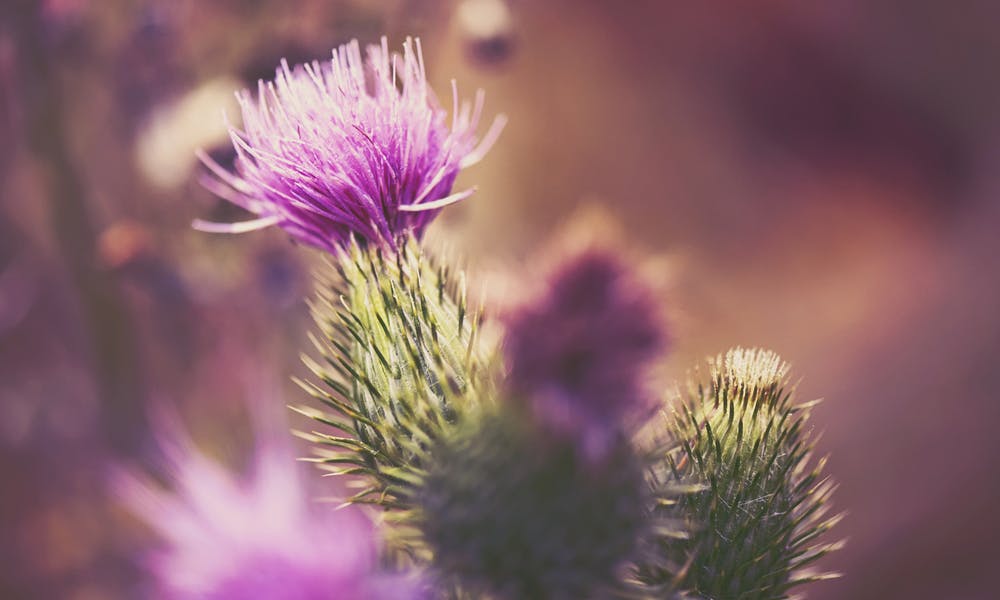MENU
The Thistle Flower: Nature’s Prickliest Flower

From the emblem of Scotland to the heated battles of France and England, the thistle flower has a storied history filled with glory and battle. One of nature’s toughest flowers, it is one of the most argued over plants in gardener circles, with some calling it a weed, and others viewing it as a healthy source of food and medicine, as well as a beautiful flower. We dive into the facts in this article and find out whether it is a worthy addition to your life.
Keep on reading to find out the:
- Thistle Flower History
- Flower Specs
- Symbolism in Culture
- Medicinal Use
- Fun Facts
- Grow Your Own
- Care and Pruning
Thistle Flower History
The thistle plant, or onopordum acanthium, is a genus of flowering plant in the Asteraceae family. There are over 200 varieties of thistle, with the Scottish thistle being the most well-known. It is predominantly found in parts of Europe. It has been naturalized in other parts of the world, with North America dealing harshly with it as it is considered an invasive weed. Although arguments abound over its status as a weed, certain varieties of biennial thistles are widely regarded as beneficial to wildlife. They produce large amounts of resources for bird and insects, such as food, material for birds’ nests, and even their foliage being used by butterflies.
Flower Specs
The thistle is a tough, difficult plant typically found in dry, arid regions. It can grow upwards of 8 feet high, with widths from 4 feet to even 19 feet, such as with the cotton thistle. There are a variety of shades although the simple green, red, and purple colors dominate. The sharp points, which give it its name cover its entire body, from stem to leaf. This adaptation was produced as a protective measurement against hungry herbivores. It has a sloping shape, somewhat like a cup or bowl. How many spikes each variety has can shift dramatically depending on the species. The thistle flower is very similar to a weed and has extensive root systems, which can cause havoc on the surrounding plants.
Symbolism in Scottish Culture
The thistle plant is the national emblem of Scotland. First instituted during the reign of King Alexander III, it then became minted on silver coins in the 15th century. One of the highest honors in Scotland is to be inducted into the order of the thistle. It is used on the flag of Montreal, Canada to represent Scotland’s part in the raising of the city. In old Scottish legend, a Norse army attempted to sneak up on the Scottish defenders while they slept at night, and would have succeeded, if not for a barefoot Norseman accidentally treading upon a thistle flower and crying out in pain, which alerted the scots to the invading armies presence. During the time of the middle ages, the thistle flower became the symbol of the Virgin Mary due to its white sap being associated with the milk dripping from her breast.
History in Lorraine
The thistle is one of the emblems of the region of Lorraine, an area in northeastern France. Before the French Revolution, much of the area was part of the duchy of Lorraine. Rene of Anjou popularized the thistle when he used it as a part of his emblem as a way of paying respect to Christianity. During the time of his grandson, Rene II, who led Lorraine as its duke, it was introduced fully into the region, gaining notoriety after the armies of Lorraine defeated the invading army of Burgundy.
Medicinal Use
The thistle flower has been used for centuries in traditional medicine for a host of illnesses. Considered a cure-all, it was even recommended for curing the plague. It was thought to be a tonic and a stimulant. Doctors used it to induce vomiting in patients as well. One of the most popular medicinal uses is for the blessed thistle, or milk thistle as it is commonly called. A chemical found within the plant known as silymarin has been quite researched for its bolstering effects on the liver and is used widely in detox and cleansing products, as well as sold individually.
Use in Cuisine
The thistle flower is surprisingly nutrient-dense, with studies finding it quite higher in vitamins and minerals in comparison to other commonly used vegetables. With careful preparation, many parts of the plant can and have been used as additions to salads and stews. Parts of the plant can also be pickled or fermented, making it a tasty side dish. Some varieties such as the bull thistle are roasted and served as a main dish. The seeds the thistle flower produces are harvested for their oil as well. The Native Americans once used the seeds somewhat like gum.
Grow Your Own
Thistle flowers require very little tending to grow into a healthy plant. A good spot that gets lots of sunlight, with a bit of water and off they go. Soil quality does not affect them, but a bit of compost can be helpful. Be wary of where you plant them, the thistle gets a lot of hate due to it easily overtaking other plants if not kept under control. Keeping it in a blocked off location is best. The thistle is beloved by finches and insects and can attract quite a lot to your garden or home, so be prepared.
The Tough Thistle Flower
The thistle flower remains a topic of debate between gardeners, as well as governments, for the foreseeable future. This tough and proliferous plant has many positive qualities to it, but for those looking to safeguard other plants, it is too like a weed to be looked upon with good thoughts. It is up to everyone to decide for themselves whether the thistle flower is the right fit for their homes, so make an informed decision!

